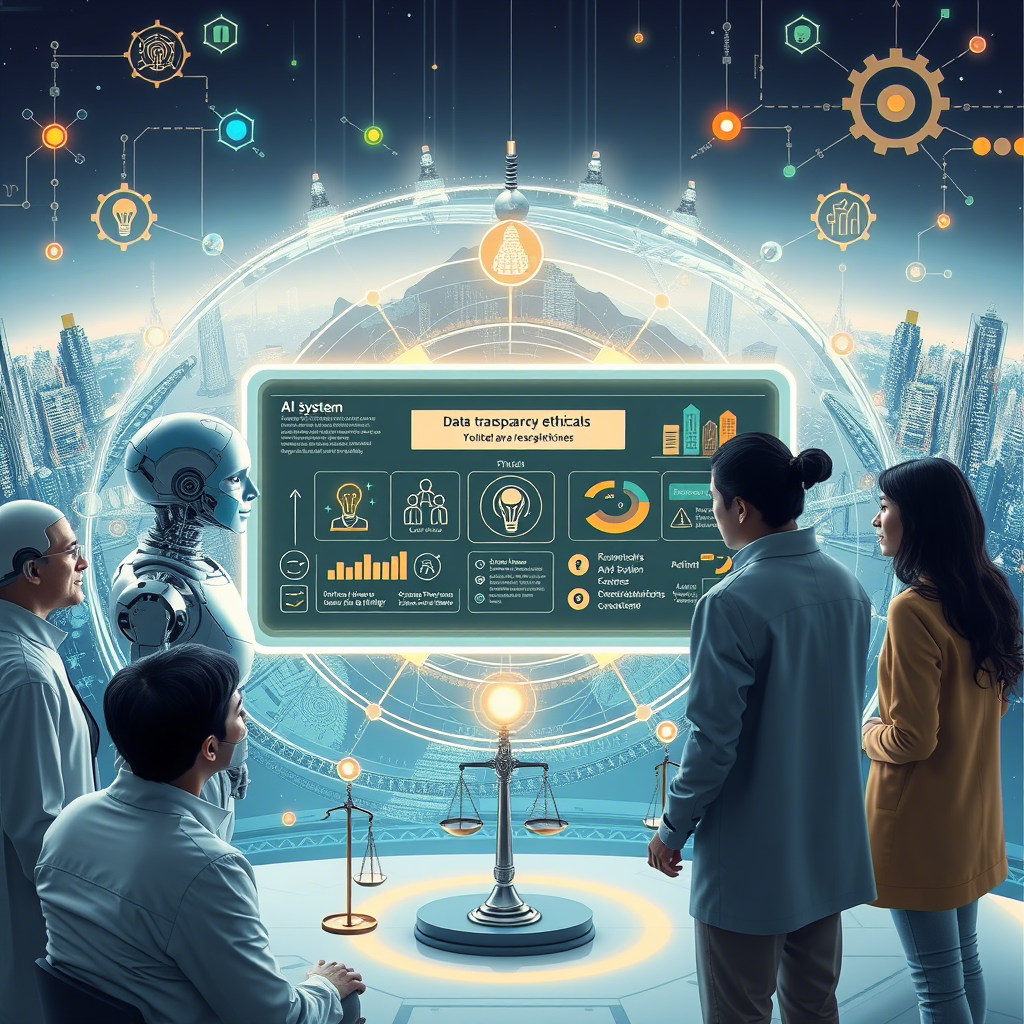Artificial intelligence (AI) is undeniably one of the most significant technological innovations of the 21st century. It has permeated nearly every sector, from healthcare to finance, education, and entertainment. However, this omnipresence is not without consequences. The rapid advancements in AI raise complex ethical, societal, and economic questions that demand careful consideration. This text aims to explore these challenges comprehensively, focusing on three main areas: the transparency of AI systems, the management of biases and prejudices, and the reduction of decision-making noise.
In a context where AI is becoming increasingly autonomous, it is crucial to understand how it operates, why it makes certain decisions, and what the implications of those decisions are for society. We will also examine future perspectives, particularly the role of AI in transhumanism, and the measures necessary to ensure that this technology serves humanity rather than dominating it.
The Importance of Transparency in AI
1.1. The Need for Explainable Artificial Intelligence (XAI)
One of the major challenges of AI lies in its often opaque nature. Traditional AI systems function as "black boxes," where internal processes remain inaccessible to users. This opacity presents a fundamental problem: how can we trust a technology whose mechanisms we do not understand? To address this issue, the concept of Explainable Artificial Intelligence (XAI) has emerged.
The goal of XAI is to transform these "black boxes" into "gray boxes," allowing for a partial understanding of outcomes and decisions. While total transparency ("white box") remains a utopian ideal, XAI aims to make AI systems transparent enough for users to follow the logical steps leading to a given decision. This approach is based on three pillars: data transparency, algorithm transparency, and result delivery transparency.
1.2. Data Transparency: An Essential Foundation
The quality of the data used to train AI systems is critical. As highlighted by the "Garbage-in-Garbage-out" (GiGo) phenomenon, erroneous or biased data produces equally flawed results. For example, if an AI system is trained with unrepresentative data, it risks replicating and amplifying the biases present in that data.
To ensure the reliability of AI systems, it is essential that users can examine the database used for training. However, this requirement often conflicts with commercial interests, especially when the data is confidential. Certification processes could be implemented to attest to the quality and representativeness of the data while respecting confidentiality constraints.
1.3. Algorithm Transparency: A Technical Challenge
AI algorithms learn autonomously, making it difficult to understand their internal mechanisms. Nevertheless, it is crucial that users can identify the key factors influencing a given decision. For instance, in the case of a credit assessment, a user should be able to understand why a loan application was approved or rejected.
Advanced techniques for visualizing and interpreting AI models are being developed to meet this need. These tools make algorithms more accessible, even though a complete understanding remains out of reach for most users.
1.4. Result Delivery Transparency: Clear Communication
Finally, the results of AI systems must be presented in a comprehensible manner, even for individuals without a background in mathematics or statistics. This involves simplifying information while preserving its accuracy. For example, an AI system used in the legal field should clearly explain why probation is recommended for a particular defendant.
Biases in AI Systems
2.1. Origins and Consequences of Bias
Biases in AI systems often stem from the data used for their training. If this data is incomplete or unbalanced, the results produced by AI will reflect these flaws. For example, a facial recognition system trained solely with photos of people from one ethnicity may struggle to accurately identify individuals from other ethnic groups.
These biases can have serious consequences, especially in sensitive areas such as hiring or justice. An AI system used to select candidates for a leadership position might favor men if the training data shows a male overrepresentation in leadership roles.
2.2. Solutions to Reduce Bias
To minimize bias, it is crucial to diversify AI development teams. A team composed of individuals of different ages, genders, nationalities, and ethnic backgrounds is less likely to introduce unconscious stereotypes into algorithms. Additionally, training data must be carefully vetted to ensure it is representative of the target population.
A data audit can also help identify and correct biases. Ideally conducted by independent third parties, this process ensures the quality and fairness of the data used.
Reducing Decision-Making Noise
3.1. The Concept of Noise in Decision-Making
Noise, or interference, refers to any disruptive element that affects the clarity or accuracy of a decision-making process. In the context of AI, noise can lead to random dispersion of decisions, even when external conditions are identical. For example, two judges might sentence a burglar to very different penalties due to contextual factors like mood or fatigue.
3.2. Strategies to Reduce Noise
To minimize the effects of noise, several strategies can be implemented. The "four eyes" principle—where a decision is reviewed by multiple people—is particularly effective. The diversity of decision-making teams also plays a key role, as it helps counterbalance individual influences.
Moreover, allowing more time for decision-making can reduce distortions related to mood or stress. Finally, using AI systems alongside human decision-makers can help identify and eliminate sources of noise.
Human-Machine Interaction
4.1. The Role of "Human-in-the-Loop"
The central idea behind the "Human-in-the-loop" model is to combine the strengths of human and artificial intelligence. In this framework, a human supervises, tests, and optimizes AI systems to improve their reliability. For example, an AI system designed to identify different bird species could benefit from human intervention to refine its criteria for distinction.
This collaboration compensates for the weaknesses of each partner. Humans bring expertise and the ability to detect anomalies, while AI offers unmatched speed and precision.
4.2. Toward Responsible AI
To ensure that AI remains a tool serving humanity, it is essential to maintain human control over automated systems. This involves not only active supervision but also ongoing ethical reflection on the use of this technology.
Conclusion: Toward an Ethical and Transparent Future
Artificial intelligence has the potential to positively transform our society, but it also carries significant risks. To maximize its benefits while minimizing its dangers, it is imperative to develop AI systems that are transparent, fair, and responsible. This requires collaboration between scientists, policymakers, and citizens, as well as a firm commitment to ethical principles.
As we move toward a future where AI will play an increasingly central role, it is crucial to lay the groundwork for a technology that respects human values. Ultimately, the goal is not simply to create intelligent machines, but to build a better world through them.

